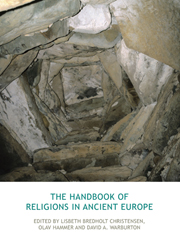Book contents
- Frontmatter
- Contents
- A note on Greek and Latin sources
- Abbreviations and short titles
- 1 Introduction
- PART I PREHISTORIC RELIGIONS
- PART II ANCIENT EUROPE IN THE HISTORICAL PERIOD
- 12 Minoan and Mycenaean religion
- 13 Etruscan religion
- 14 The religions of the Iberian Peninsula
- 15 Italic religion
- 16 Roman religion
- 17 Ancient Greek religion
- 18 The Graeco-Roman cult of Isis
- 19 The cult of Mithras
- 20 Religious Platonism: philosophy and religion in the Platonic tradition
- 21 Insular Celtic religion
- 22 Continental Germanic religion
- 23 Pre-Christian Anglo-Saxon religion
- 24 Old Norse religion
- 25 Slavic religion
- 26 Baltic religion
- 27 Religion in prehistoric Finland
- 28 Sami religion
- Timeline of key dates
- Contributors
- References
- Index
25 - Slavic religion
from PART II - ANCIENT EUROPE IN THE HISTORICAL PERIOD
- Frontmatter
- Contents
- A note on Greek and Latin sources
- Abbreviations and short titles
- 1 Introduction
- PART I PREHISTORIC RELIGIONS
- PART II ANCIENT EUROPE IN THE HISTORICAL PERIOD
- 12 Minoan and Mycenaean religion
- 13 Etruscan religion
- 14 The religions of the Iberian Peninsula
- 15 Italic religion
- 16 Roman religion
- 17 Ancient Greek religion
- 18 The Graeco-Roman cult of Isis
- 19 The cult of Mithras
- 20 Religious Platonism: philosophy and religion in the Platonic tradition
- 21 Insular Celtic religion
- 22 Continental Germanic religion
- 23 Pre-Christian Anglo-Saxon religion
- 24 Old Norse religion
- 25 Slavic religion
- 26 Baltic religion
- 27 Religion in prehistoric Finland
- 28 Sami religion
- Timeline of key dates
- Contributors
- References
- Index
Summary
SOURCES FOR SLAVIC RELIGION
Our knowledge of Old Slavic mythology and religion is quite limited. Most of the available information was recorded during and after the conversion of the Slavs to Christianity in the ninth to twelfth centuries CE and consists of very brief references of foreign provenience, usually written in Greek, Latin and Arabic. Archaeological sources do not enable us to look much deeper into the past as there is still no conclusion to the discussion of precisely how and whence the Slavs originated. This means that before about the fifth century CE, when the earliest Slavic pottery of the Prague type appears, it is impossible to connect archaeological evidence to a Slavic population with any certainty. Written records concerning Slavic pre-Christian religion (with few exceptions) cover only two regions: some parts of Kievan Rus and some of Polabia (located in what is today north-eastern Germany). The most important sources will be discussed in the following sections.
Procopius of Caesarea and Thietmar's Chronicle
The sixth-century CE writer Procopius of Caesarea (De bello gothico [On the Gothic War] 3.14.23–4) is the first author to discuss Slavic religion. He mentions two Slavic tribes, the Sclavinoi and Anthoi (who were dwelling somewhere in the Dniestr and Dnepr region at that time), and states that they worshipped as their main deity a god of thunder, astrapes demiurgos (literally “creator of lightning”).
- Type
- Chapter
- Information
- The Handbook of Religions in Ancient Europe , pp. 338 - 358Publisher: Acumen PublishingPrint publication year: 2013



